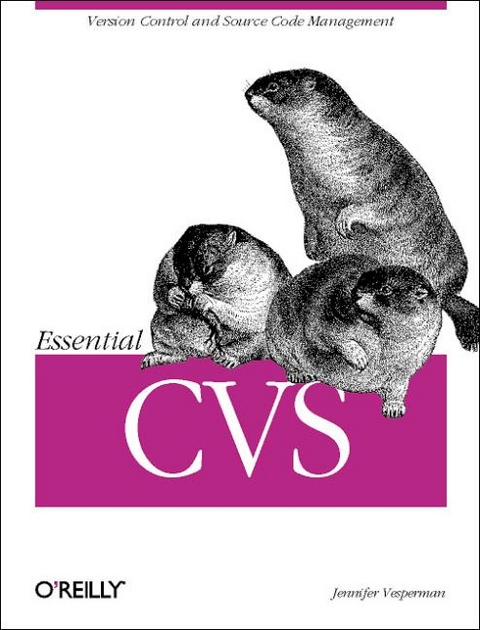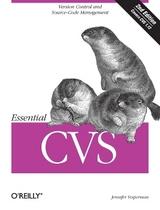
Essential CVS
O'Reilly Media (Verlag)
978-0-596-00459-0 (ISBN)
- Titel erscheint in neuer Auflage
- Artikel merken
CVS, the Concurrent Versions System, is the popular source-code management tool that frees developers from the chaos that too often ensues when multiple users work on the same file. An open source technology that is available on most computer platforms, including Windows and Mac OS X, CVS is widely used to manage program code, Web site content, and to track changes made to system configuration files. Multiple users can check out files from a directory tree, make changes, and then commit those changes back into the directory. If two developers modify the same file, CVS enables both sets of changes to be merged together into one final file. This text is a complete and easy-to-follow reference that helps programmers and system administrators apply order to the task of managing large quantities of documents. It covers basic concepts and usage of CVS, and features a comprehensive reference for CVS commands - including a handy Command Reference Card for quick, on-the-job checks. The book also includes advanced information on all aspects of CVS that involve automation, logging, branching and merging, and "watches."
Readers will find in-depth coverage of the following: installing CVS and building your first repository; basic use of CVS, including importing projects, checking out projects, committing changes, and updating projects; tagging, branching and merging; working with multiple users; clients, operating systems, and IDEs; repository management and managing remote repositories; project administration, including bug tracking systems, enforcing log messages; and history and annotation. Version control is essential to maintaining order in any project, large or small. Any CVS user, from beginners to team leaders and system administrators, should find this practical guide to CVS indispensable in getting the most from this valuable tool.
Jennifer Vesperman is the author of Essential CVS. She writes for the O'Reilly Network, the Linux Documentation Project, and occasionally Linux.Com. As a programmer and system administrator, she currently works with Cybersource, an Australian IT consulting firm. She is the current Coordinator for LinuxChix, an advocacy and support group that focuses on women who use and develop open source programs (especially Linux).
Preface Part I. Introduction 1. What Is CVS? What Is a Versioning System? CVS in the Field 2. CVS Quickstart Guide Installing CVS Building Your First Repository Importing Projects Accessing Remote Repositories Checking Out Files Committing Changes Updating Sandboxes Adding Files Removing Files Quick Tips for Success Part II. Using CVS 3. Basic Use of CVS General Information Sandboxes and Repositories Committing Changes to the Repository Checking File Status Updating the Sandbox Files from the Repository Adding Files to the Repository Removing Files from the Repository Moving Files or Directories Releasing a Sandbox Keywords Binary Files and Wrappers Specifying Default Command Options 4. Tagging and Branching Tagging Stickiness Branching Branching Strategies 5. Multiple Users Using Simultaneous Development Watching a File Reserving Files Comparing File Revisions Displaying Recent Changes Displaying File History Part III. CVS Administration 6. Repository Management Creating a Repository Deleting a Repository Securing Your Projects Repository Structure CVSROOT Files Server Environment Variables Backing Up a Repository Editing a Repository Sandbox Structure Client Environment Variables Exit Status 7. Project Management Creating a Project Distributing Files Running Scripts Interfacing with External Programs Tools Strategies and Practices 8. Remote Repositories Specifying Repository Paths The local Access Method The ext and server Access Methods The fork Access Method The gserver Access Method The kserver Access Method The pserver Access Method Using inetd with gserver, kserver, and pserver 9. Troubleshooting General Troubleshooting Techniques Connectivity Problems Filename Problems Line-Ending Problems Permission Problems Lock Files Part IV. Reference 10. Command Reference CVS Command-Line Options CVS Commands 11. Miscellaneous Topics Reference Administrative Files CVSROOT Files CVSROOT Variables Dates Environment Variables Keywords and Keyword Modes Pattern Matching Repository Access Methods Part V. Appendixes A. Clients and Operating Systems B. Administrator's Tools Index
| Erscheint lt. Verlag | 15.7.2003 |
|---|---|
| Zusatzinfo | index |
| Verlagsort | Sebastopol |
| Sprache | englisch |
| Maße | 181 x 234 mm |
| Gewicht | 546 g |
| Einbandart | kartoniert |
| Themenwelt | Mathematik / Informatik ► Informatik ► Betriebssysteme / Server |
| Mathematik / Informatik ► Informatik ► Software Entwicklung | |
| ISBN-10 | 0-596-00459-1 / 0596004591 |
| ISBN-13 | 978-0-596-00459-0 / 9780596004590 |
| Zustand | Neuware |
| Haben Sie eine Frage zum Produkt? |
aus dem Bereich



